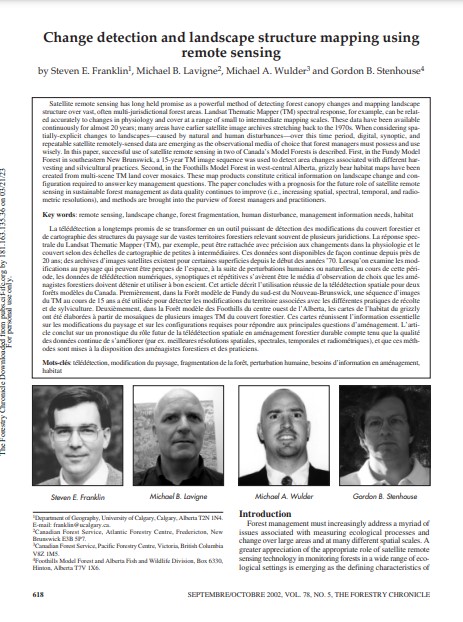Change Detection and Landscape Structure Mapping Using Remote Sensing
Bosque Modelo:
Foothills
Temática:
Gestión forestal
Tipo de documento:
Artículo científico
Resumen
Satellite remote sensing has long held promise as a powerful method of detecting forest canopy changes and mapping landscape structure over vast, often multi-jurisdictional forest areas. Landsat Thematic Mapper (TM) spectral response, for example, can be related accurately to changes in physiology and cover at a range of small to intermediate mapping scales. These data have been available continuously for almost 20 years; many areas have earlier satellite image archives stretching back to the 1970s. When considering spatially-explicit changes to landscapes—caused by natural and human disturbances—over this time period, digital, synoptic, and repeatable satellite remotely-sensed data are emerging as the observational media of choice that forest managers must possess and use wisely. In this paper, successful use of satellite remote sensing in two of Canada’s Model Forests is described. First, in the Fundy Model Forest in southeastern New Brunswick, a 15-year TM image sequence was used to detect area changes associated with different harvesting and silvicultural practices. Second, in the Foothills Model Forest in west-central Alberta, grizzly bear habitat maps have been created from multi-scene TM land cover mosaics. These map products constitute critical information on landscape change and configuration required to answer key management questions. The paper concludes with a prognosis for the future role of satellite remote sensing in sustainable forest management as data quality continues to improve (i.e., increasing spatial, spectral, temporal, and radiometric resolutions), and methods are brought into the purview of forest managers and practitioners.
Información Bibliográfica
Autor:
Franklin, SE, MB Lavigne, MA Wulder and GB Stenhouse.
Revista:
Forestry Chronicle
Año:
2002
N°:
5
País :
Canadá
Páginas:
618 - 625
Volumen:
78
Idioma:
Ingles
Palabras claves
remote sensing, landscape change, forest fragmentation, human disturbance, management information needs, habitat





